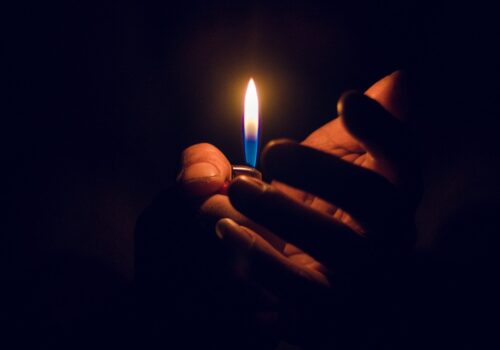Download PDF: Bielo, Doing Religious Studies Dialogically
* Editors’ Note: This essay is part of the Roundtable on Ethnography and Religion.
As a die-hard ethnographer, I could not be more sympathetic with the kind of religious studies Robert Orsi articulates. The “disciplined attentiveness” he describes is precisely what I hope for on my best days in the field. He captures a dilemma I have confronted in the throes of ritual, in the midst of transcribing interviews, and in writing: how to represent religion-in-context without surrendering religion to context and without dissolving the most meaningful portion of a life to just another part of life.
But, as with any good provocation, I was provoked by Orsi’s essay. In particular, I am moved to think more about his idea of doing religious studies “with your whole body.” As a counterproposal, I’d like to prioritize doing religious studies as dialogically as possible. I have Bakhtin in mind, and the continual dialogue among what is, what was, what might be, and the ideological chattering that engulfs each.1 While we certainly do ethnography with our body, our whole body, we also do it with our pasts in tow, in relation to the bodies and pasts of those who populate our fieldwork, and in constant exchange with our theoretical and methodological frames. Moreover, ethnography is fundamentally relational. It is about seeking, cultivating, damaging, losing, restoring, remembering, and celebrating relationships. Our whole bodies make no sense apart from those whole bodies we are sitting among and listening to with “disciplined attentiveness.”
Recently, I initiated my third major ethnographic project among American evangelicals. The first was a discourse-centered, comparative analysis of small group Bible study. My concerns organized around talk, reading, text, local hermeneutics, and rituals of gathering. Some of the groups had been together for decades, and they allowed me to intrude on their intimacy, tape-recorder, notepad, and all. The second was a multi-sited analysis of a movement of cultural critique (the Emerging Church), which was intent on distinguishing itself from mainstream evangelicalism and, hopefully, building an alternative evangelicalism. Mostly, I spent time with men and women who were dreaming, creating, experimenting, and gambling. They had lots of energy and lots of ideas; many of them had lots of education, but rarely the financial backing to boot.
In each, a dialogical ethnographic posture seemed the most viable choice. In the Bible study work, the groups’ ongoing efforts to read and be together drew me to congregational histories, the voluminous scholarly and popular debates about scriptural interpretation, the emotional and moral lives of participants, and the vividly intertextual (and always eventually idiosyncratic) repertoires that emerged. (For instance, in just one book study in one group, all of the following sources made appearances: The Passion of the Christ, C.S. Lewis, NPR, Queer Eye for the Straight Guy, Lord of the Rings, Stephen Hawking, Mark Twain, The Keystone Cops, Joel Osteen, Charles Dickens, The Far Side, Forrest Gump, Johnny Cash, Star Wars, Jerry Maguire, The Prayer of Jabez, Oprah, Rick Warren, and The History Channel.)
In the Emerging Church work, different dialogues took center stage through different phases of the research. At first, the major exchange I had to understand was that between my consultants’ present and past selves. In the stead of born-again narratives, they spoke a de-conversion narrative, detailing the trials of faith and life that left them at odds with mainstream evangelical “culture.” Later, I explored engagements with place. Middle-class idioms of suburban aspiration and urban danger, inextricably linked to America’s post-WWII changes, were replaced by a dripping loathing for suburban isolation and deluded comfort and a desire to redeem urban existence.
In both projects, I had my own dialogues to manage. In a world where models of literalism and evangelical dogmatism reign, how do I bear truth to an experience defined by lively and always searching readers? When surrounded by evangelicals who talk, read, ritualize, remember, and engage the public sphere in ways that challenge all preconceptions of who evangelicals are supposed to be, how do you write their lives? And, of course, there were the many dialogical moments with the non-human. How do I read and respond to their signs of “God moving”? When the “presence of the Spirit” is declared, what happens to my ethnographic presence?
At present, I am immersed in an equally dialogical, yet strikingly different, work: an ethnography of a creationist theme park-in-the-making. In December 2010, the governor of Kentucky announced that a $150 million theme park was planned for an 800-acre site 40 miles south of Cincinnati. Ark Encounter is being produced by the young earth creationist ministry Answers in Genesis, the same ministry and creative team who designed the 2007 Creation Museum. The centerpiece of the park will be an all-wood Noah’s Ark built to the cubit dimensions recorded in the book of Genesis. In October 2011, I was granted permission by the Ark Encounter team to observe their planning and development of this park, from the conceptual and design work they had recently begun and culminating in the park’s opening. The first eight months was, looking back, very strange fieldwork.
There is the contingency of it all. The park’s coming to fruition entails massive fundraising. Will they ever raise it? The proposed $150 million project has already been scaled down to a roughly $40 million Phase One. If they can raise this money, when will it happen? They have pushed back a ceremonial groundbreaking several times. Will it be “in God’s time,” as the team continually says to me and to each other? What does God’s time have to do with other temporalities: social, scientific, social scientific, biblical, capitalist, and the political motions of a presidential election year?
I am essentially doing ethnography by appointment. I cannot go to the creative team’s office anytime I want; I must plan each visit with the administrative assistant, and they have rescheduled or cancelled numerous times. At first, I approached every visit as potentially my last. What are the limits of my access? So far, the only thing off-limits has been the ministry’s monthly board meetings. But, will there come a time when the unfettered access I’ve been granted is restricted or rescinded? Then, there is the seeming banality of doing office ethnography. I spend most of my time in cubicles! In a stroke of Geertzian literalism, I spend most of that time reading over shoulders—not words, but images in Photoshop and Dreamweaver. Quickly, I learned that this fieldwork would thrive on mastering the art of sitting, watching, waiting, asking strategically-timed questions, and, as much as anything, not being a nuisance to workers on a clock and under deadlines.
There is the office talk. To be sure, there are occasional references to “millions of years thinking,” “secular people,” “God’s timing,” and reminders that “this whole thing is about showing people Jesus.” But, mostly, there is an absence of marked religious language in this overtly religious context. God-talk, Jesus-talk, Bible-talk, prayer, theology, and the like are confined to passing encounters and specific moments (to open a team meeting, for example). Mostly, office talk is artistic and pragmatic. Creative team members offer impromptu feedback on a sketch of an attraction. Assessments are made in terms of being “cool,” “interesting,” “boring,” “fun,” or “entertaining”; not, say, inspiring, reverent, meditative, or, even, biblical. The facilities manager asks the artists for more detail in order to build, exchanges akin to, “This is a great idea, I love it. But, what do you see for the dimensions on this line here?” All of this is not to say that I am waiting for the real religious work to begin. It, of course, is in full swing. I am working in the spirit of avoiding what Orsi warns against, “already always know[ing] what religion is”; or, for that matter, already knowing what theology, prayer, or worship are.
Arguably, the weightiest dialogue surrounding my work with the Ark Encounter creative team is America’s ongoing creationism-evolution battle, itself nested in our larger drama of religion-science. (Question: is a war metaphor, “battle,” our best, or only, choice?) Despite the fact—or, better yet, alongside the fact—that most of office life appears caught up in the minutia of theme park design, the entire project is deeply embedded in the politics of public school curriculum, state and federal court rulings, election rhetoric, and, as an approved application by Ark Encounter LLC to the Kentucky State Board of Tourism shows, business tax incentives. If schools are one kind of public, leisure is another; and, in this sense, the Ark Encounter is most certainly an act of public religion. If the Ark succeeds—that is to say opens, perhaps eventually profiting—will this amount to a victory in the court of public entertainment?
An unexpected dialogue has been the intertextual making of creationist concept art. In sitting with creative team members while they work, as well as in more formal interviews with them, it has become clear that their labor is defined by inspiration and reference. They are constantly citing artists and artworks as models. One member keeps a large cache of images saved on his desktop, which he ritually flips through to find needed sparks of invention. Bookshelves around the office are packed with art books—Star Wars, Jurassic Park, Lord of the Rings, Chronicles of Narnia, Star Trek, Dinotopia, Avatar, The Last Airbender, andKing Kong—constantly on the move from shelf to desk and back again. The team styles themselves as “imagineers,” a self-conscious, and not the least bit ironic or apologetic, nod to Disney’s mastery in creating “immersion experiences” for park guests. Their imagineering labor is dialogical to the core; they are always working relationally to model after, capture, or avoid recognizable art forms. Attending to this element of their work is not simply about being truthful to their generative intertextuality. It has also led me to an early insight about the nature of their cultural production. Whatever else they are doing, the team is engaging in a form of fantasy world-making (note the common theme among the bookshelf references listed above). Yet, they are also working with a literal view of biblical time. It seems their making of Noah’s world is caught between creationist models of real history and what they consider “interesting” ways to conjure a “pre-Flood culture.” Is there an elective affinity between creationist literalism and fantasy world-making?
At least one more dialogue presses immediately on my attempt to render the work of creationist imagineers legible. I have in mind the vitriolic bias against young earth creationism. When I explain this project to colleagues, jaws drop, heads fly back in disbelief, eyes widen, and a mix of surprised and mocking laughter tumbles out. Creationists are reviled by many, and this is not a point to elide too hastily. While I certainly have no stake in defending creationists, or this ministry’s choice of how best to use $150 million, I very much want to write against the grain of revilement, disdain, and easy satire. One strategy for doing so invokes another dialogue, one between contemporary Americans and our national past. From one angle, Answers in Genesis is simply the latest in a venerable tradition of trying to make leisure meaningful. Historians like Troy Messinger (Holy Leisure), Bruce Daniels (Puritans at Play), and Aaron Ketchell (Holy Hills of the Ozarks) have unearthed a deep American Protestant impulse to fuse play and piety. One of America’s great populist oracles, John Steinbeck, indulged a similar meditation in his 1966 non-fiction essay “Americans and the Future.”2 He concludes a laundry list of social ills with this problem of meaningful leisure:
We have the things and we have not had time to develop a way of thinking about them. We struggle with our lives in the present and our practices in the long and well-learned past. We have had a million years to get used to the idea of fire and only twenty to prepare ourselves for the productive-destructive tidal wave of atomic fission. We have more food than we can use and no way to distribute it. Our babies live and we have no work for their hands. We retire men and women at the age of their best service for no other reason than that we need their jobs for younger people. To allow ourselves the illusion of usefulness we have standby crews for functions which no longer exist. We manufacture things we do not need and try by false and vicious advertising to create a feeling of need for them. We have found no generally fulfilling method for employing our leisure.3
*****
I hope not to have strayed too far or too deep into ethnographic particularity. My aim has only been to stand by the suggestion that we do religious studies as dialogically as possible. In my first two projects, and equally so with the Ark Encounter, I have found a dialogical posture indispensable in navigating the fieldwork itself and in striving to make some sense of what I have seen.
For two reasons, I will conclude with some inspiring intertextuality of my own. Orsi’s stance that studying religion is apt to leave us “chastened, unsettled … often distressed in some way, and exhausted” makes absolute sense for his work with adult survivors of Catholic clerical sex abuse. But, it is not our only option. The Ark Encounter forces me to grapple with the idea of religious fun, an idea that many would take to be a contradiction-in-terms. This reminds me, though, of something Keith Basso wrote in reflecting on his fieldwork among the Western Apache:
It is better to write of things one believes one knows something about than to anguish in high despair over the manifold difficulties of knowing things at all. And better as well, having taken the plunge, to allow oneself to enjoy it. Doing ethnography can be a great deal of fun, and disguising the fact on paper, as though it were something to be ashamed of, is less than totally honest. It may also be less than effective. Current fashions not withstanding, clenched teeth and furrowed brow are no guarantee of literary success. In crafting one’s prose, as in going about one’s fieldwork, it is always permissible—and sometimes highly informative—to smile and even to laugh.4
Perhaps this ethnographic posture clears a path toward capturing a grandiose act of religious fun and, when the Spirit moves, to laugh with the Ark team but never at them.
Notes
- See M.M. Bakhtin, The Dialogic Imagination: Four Essays(Austin: University of Texas Press, 1981) and Michael Holquist, Dialogism: Bakhtin and his World (London: Routledge, 1990).
- John Steinbeck, America and Americans and Selected Nonfiction (New York: Penguin, 2002).
- Ibid., 398.
- Keith H. Basso, Wisdom Sits in Places: Landscape and Language among the Western Apache (Albuquerque: University of New Mexico Press, 1996), 111.






